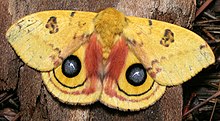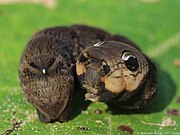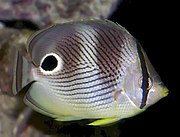Eyespot (mimicry)

An eyespot (sometimes ocellus) is an eye-like marking. They are found in butterflies, reptiles, cats, birds and fish.
Eyespots could be explained in at least three different ways. They may be a form of
The pattern-forming biological process (
Artificial eyespots have been shown to reduce predation of cattle by lions.
Zoological distribution
In butterflies and moths


The eye-like markings in some
Some species of caterpillar, such as those of hawkmoths (Sphingidae), have eyespots on their anterior abdominal segments. When alarmed, they retract the head and the thoracic segments into the body, leaving the apparently threatening large eyes at the front of the visible part of the body.[5]
Butterflies such as the blues (
In reptiles and mammals
Some reptiles, such as the sand lizard of Europe, have eyespots; in the sand lizard's case, there is a row of spots along the back, and a row on each side.[12]
Many species of
In birds

Male birds of some species, such as the
In fish
Some fish have eyespots. The
-
Larva of elephant hawkmoth (Deilephila elpenor) displaying eyespots when alarmed
-
Larva of puss moth (Cerura vinula) in a defensive posture, with black eyespots visible just above its head
-
gray hairstreak(Strymon melinus) has false head at rear
-
Sand lizard (Lacerta agilis) with rows of eyespots
-
Pygmy owl(Glaucidium californicum) with eyespots behind head
-
Serval (Leptailurus serval) from back, ocelli clearly visible on the ears
-
Foureye butterflyfish (Chaetodon capistratus) has false eyes near tail and disruptive eye mask concealing eye
Morphogenesis

Butterfly eyespots are formed during
Early experiments on eyespot morphogenesis used
Butterfly eyespot morphology appears to be the result of the
Distal-less
The Distal-less gene is present in almost all eyespot organizers, making it an ideal candidate to carry out major functions of eyespot formation. During the wing imaginal disc development Dll, has two expression domains separated by a temporal component. First Dll is expressed in a group of cells in the center of what will become the focus and eventually the eyespot. This expression starts during the middle of the fifth
Hedgehog
The Hedgehog (Hh) gene is the other element that has been functionally tested in the formation of eyespots. Investigating genes involved in wing development and morphogenetic activity has led to the discovery that Hh has a primary role in the morphogenetic signaling center of the foci.[23] In a manner that is similar to the development of Drosophila fruit flies, Hh is expressed in all cells in the posterior compartment of the developing butterfly wing during the mid fifth instar of butterfly wing development. However, in butterflies, Hh expression is significantly higher in those cells that flank the potential foci.[23] Higher transcription levels of Hh, along with other known associates of the Hh pathway, namely patched (Ptc) the Hh receptor, and cubitus interruptus (Ci), the Hh transcription factor is seen throughout the mid to late fifth instar as well, which further implies a role for Hh signaling in eyespot development and patterning.[23]
Furthermore, cells that are flanked by the cells expressing the highest level of Hh signaling are fated to become the foci, indicating that focus cell fate determination relies on high concentrations of Hh in surrounding cells.[23] However, this observation has not been totally confirmed as a rule for multiple butterfly species.[25] Studies tried to extrapolate the result of Hh pathway involvement by looking for the expression of Ci in Bicyclus anynana.[23] Here they observed that both seem to be expressed in eyespots, suggesting a relation with the Hh signaling pathway. However, other studies did not find evidence of Hh expression in B. anynana.[25]
Notch
The Notch (N) gene expression precedes an upregulation of Dll in the cells that will become the center of the focus. This makes N the earliest developmental signal, so far studied, that is related with the establishment of the eyespots. Loss of N completely disrupts Dll expression, and eventually eyespot formation, in several butterfly species. A variety of other wing patterns are determined by N and Dll patterns of expression in early development of the wing imaginal disc, suggesting that a single mechanism patterns multiple coloration structures of the wing.[26]
Evolution
Butterfly eyespots are formed by an interplay of at least 3 genes, namely Distal-less (Dll), spalt (sal), and Antennapedia (Antp), hence their evolution has been shaped by differential expression of these genes in different butterfly taxa, as shown in Bicyclus anynana.[27]
Artificial eyespots

Eyespots painted on the rumps of cows have been shown to reduce cattle predation in Africa. The study authors, Cameron Radford and colleagues, note that in the
See also
References
- S2CID 1832497.
- doi:10.1093/czoolo/60.1.26. Archived from the original(PDF) on 2013-12-12.
- PMID 16024383.
- S2CID 20443102.
- ^ S2CID 24868603.
- PMID 32041684.
- PMID 17251116.
- PMID 12065039.
- PMID 30794728.
- S2CID 84454608.
- S2CID 34146954.
- ^ "Reptile ID guide". Amphibian and Reptile Group. Retrieved 11 April 2016.
- ISBN 978-0-226-51823-7.
- PMID 31851714.
- S2CID 53201236.
- S2CID 53167596.
- ^ "Northern Pygmy Owl (Glaucidium californicum)". Owl Research Institute. Archived from the original on 28 December 2015. Retrieved 23 August 2015.
- ^ Froese, Rainer; Pauly, Daniel (eds.) (2009). "Chaetodon capistratus" in FishBase. July 2009 version.
- Cott, Hugh B.(1940). Adaptive Coloration in Animals. Oxford University Press. p. 373.
- S2CID 8456367.
- PMID 22375251.
- ^ S2CID 3341270.
- ^ PMID 9915699.
- ^ hdl:1887/11021.
- ^ PMID 25341098.
- PMID 15242612.
- PMID 35169073.
- ^ PMID 32770111.









